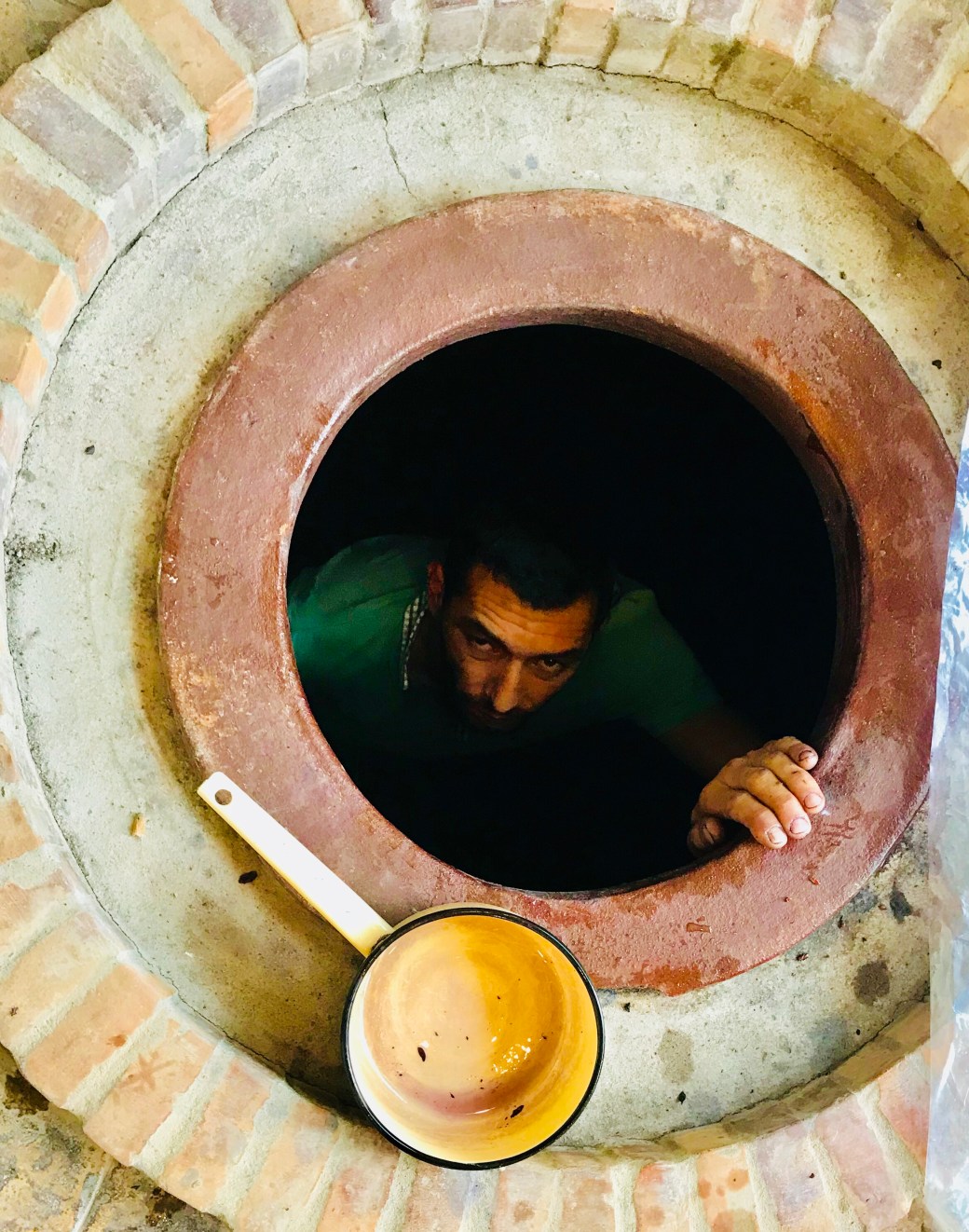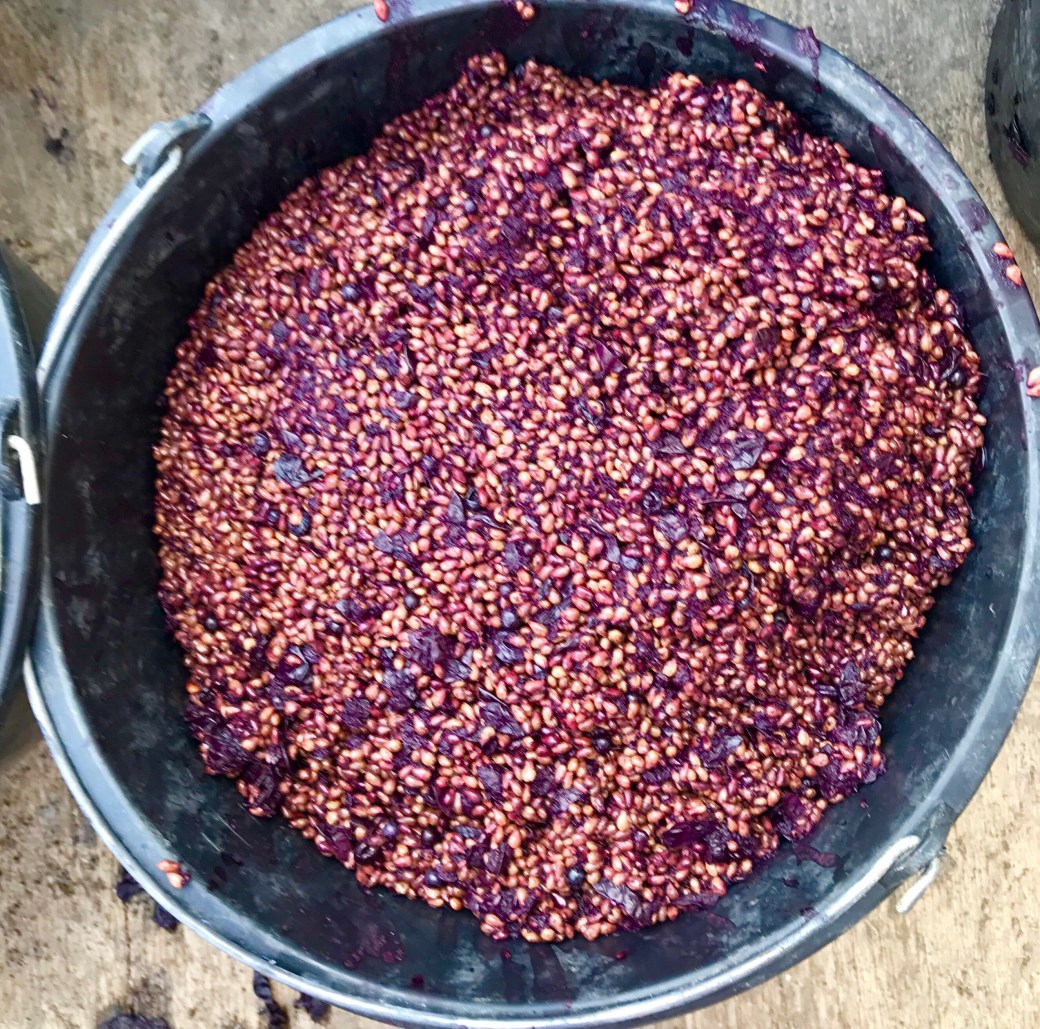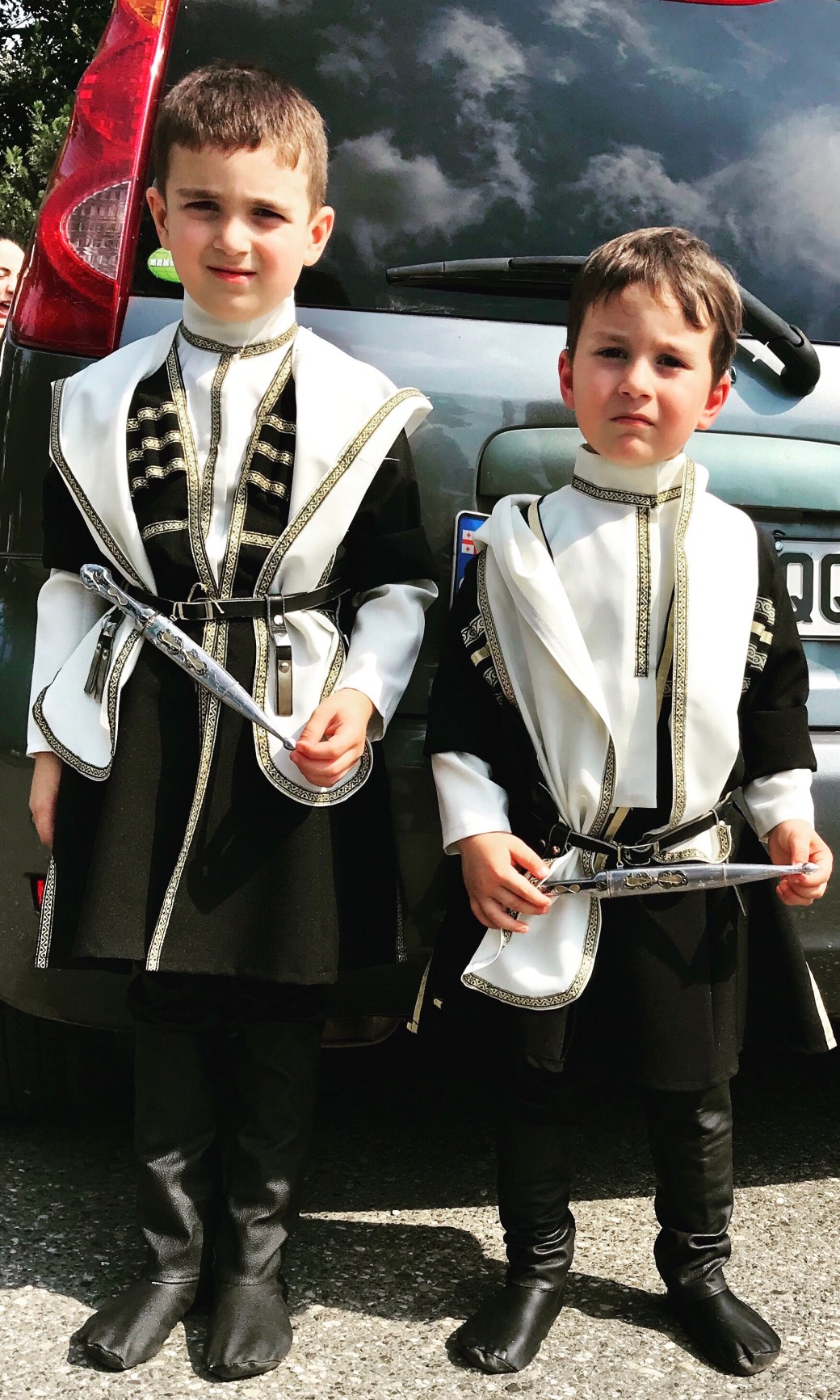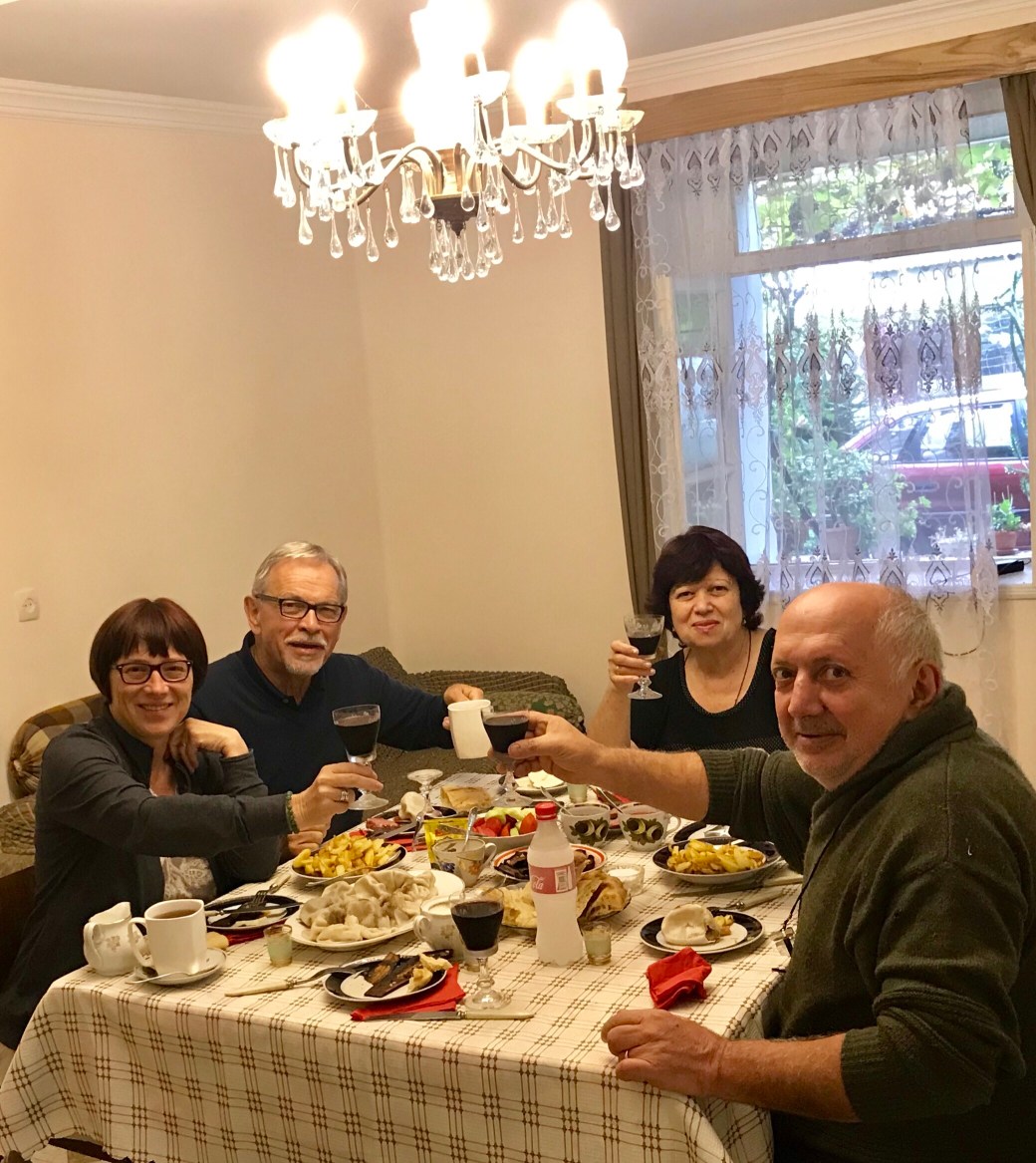Little did we know that one simple choice – a choice of our hotel in Kaheti – the famed wine region of Georgia, will lead to a travel dream come true.  After some quite simple and very cheap accommodations we felt we could splurge a little and book a better hotel for a few days. We found a brand new establishment on the net – Babaneuris Marani (marani=wine cellar) in the shadow of Tusheti range, the wildest mountains of Georgia. It had a contemporary design and a swimming pool set amidst the vines and what we only found out upon arrival, a wonderful young Georgian couple running the show: Vakho, the wine production and Nino, the hotel. This young woman,
After some quite simple and very cheap accommodations we felt we could splurge a little and book a better hotel for a few days. We found a brand new establishment on the net – Babaneuris Marani (marani=wine cellar) in the shadow of Tusheti range, the wildest mountains of Georgia. It had a contemporary design and a swimming pool set amidst the vines and what we only found out upon arrival, a wonderful young Georgian couple running the show: Vakho, the wine production and Nino, the hotel. This young woman,  a mother of three small children, an MBA student at Tbilisi University was the epitome of hard working and capable Georgian women with a can do attitude, a lovely smile, and perfect English to boot. And she is bucking the trend of Georgian patriarchy. I saw that even her father in law was dealing with her as an equal, a welcome sight in a country where women tend to do a lot of hard work and have little say. Of course the younger generation is changing, but even there Nino complained that some of her girlfriends in Tbilisi were not allowed by their husbands to go out with her in the evenings. “Not that my sweet husband would ever do that,” she said with a sly smile. “But if he tried, I would kill him!”
a mother of three small children, an MBA student at Tbilisi University was the epitome of hard working and capable Georgian women with a can do attitude, a lovely smile, and perfect English to boot. And she is bucking the trend of Georgian patriarchy. I saw that even her father in law was dealing with her as an equal, a welcome sight in a country where women tend to do a lot of hard work and have little say. Of course the younger generation is changing, but even there Nino complained that some of her girlfriends in Tbilisi were not allowed by their husbands to go out with her in the evenings. “Not that my sweet husband would ever do that,” she said with a sly smile. “But if he tried, I would kill him!”
It is said that Georgia is the cradle of winemaking.  The original tradition of “amphora” wine making is still alive and well. When we say amphora wine we imagine elegant Greek or Roman clay amphoras deep under the sea in the hulls of sunken transport ships. But before that wine could be put into amphoras for transport it was made in huge underground amphoras with a very different process of winemaking than the barrel aged wine production we know.
The original tradition of “amphora” wine making is still alive and well. When we say amphora wine we imagine elegant Greek or Roman clay amphoras deep under the sea in the hulls of sunken transport ships. But before that wine could be put into amphoras for transport it was made in huge underground amphoras with a very different process of winemaking than the barrel aged wine production we know.  Here after the grapes are picked they are pressed (in the older times they were stomped barefoot in huge wooden tubs) and then everything, stems, skins and pits included, is put into the quevri – special hand made clay amphoras, where it undergoes natural fermentation.
Here after the grapes are picked they are pressed (in the older times they were stomped barefoot in huge wooden tubs) and then everything, stems, skins and pits included, is put into the quevri – special hand made clay amphoras, where it undergoes natural fermentation.
Afterwards the wine juice is pumped out and leftover skins and pips are removed by hand
 and a fiery chacha (Georgian version of grappa) is distilled from the leftovers.
and a fiery chacha (Georgian version of grappa) is distilled from the leftovers.
 Besides our own Babaneuris cellar we stopped at a number of other well know cellars from old Alaverdi Monastery vineyard
Besides our own Babaneuris cellar we stopped at a number of other well know cellars from old Alaverdi Monastery vineyard  to new Shumi and Qvareli for tours and wine tasting. Many of the vineyards grew a demonstration vineyard where they showcased hundreds of local grape varieties. All in all there are 500 Georgian varieties of grapes. Imagine the combinations (blends) a winemaker can come up with! In one of the biggest wineries we were lucky to be serenaded by a group of traditional musicians. They have the most wonderful voices and harmonies.
to new Shumi and Qvareli for tours and wine tasting. Many of the vineyards grew a demonstration vineyard where they showcased hundreds of local grape varieties. All in all there are 500 Georgian varieties of grapes. Imagine the combinations (blends) a winemaker can come up with! In one of the biggest wineries we were lucky to be serenaded by a group of traditional musicians. They have the most wonderful voices and harmonies.
What is even more impressive is their spectacular dancing – a cross between ballet, folk dancing and acrobatics! They are really keen on keeping this tradition alive and they start encouraging their kids young.  Our new Czech and American friends were quite enthusiastic about Georgian Saperavi and Mtsvane wines. We, on the other hand were quite glad that a wholly 90% of Georgian wine production is of French winemaking style as we enjoyed more their classic pinots and such.
Our new Czech and American friends were quite enthusiastic about Georgian Saperavi and Mtsvane wines. We, on the other hand were quite glad that a wholly 90% of Georgian wine production is of French winemaking style as we enjoyed more their classic pinots and such.  Truth be told the wine we liked the best of all was a homemade batch that we shared with an Airbnb host family in Lagodekhi National Park Area. If you are lucky to experience traditional Georgian hospitality you will share great food and many beautiful toasts!
Truth be told the wine we liked the best of all was a homemade batch that we shared with an Airbnb host family in Lagodekhi National Park Area. If you are lucky to experience traditional Georgian hospitality you will share great food and many beautiful toasts!  We arrived at this home in the late afternoon and were greeted enthusiastically by the man of the house who quickly called his son, a young man on vacation from his high powered government job in the capital. His English was amazing and we had a great conversation over tea. Then all hell broke loose. Mom arrived from work (as a doctor), took one look and started wailing, “How could you bring such shame on our house and let our honored guests sit at an empty table!” Despite our objections she did not stop until every square inch was covered by khinkali (special dumplings) and other food.
We arrived at this home in the late afternoon and were greeted enthusiastically by the man of the house who quickly called his son, a young man on vacation from his high powered government job in the capital. His English was amazing and we had a great conversation over tea. Then all hell broke loose. Mom arrived from work (as a doctor), took one look and started wailing, “How could you bring such shame on our house and let our honored guests sit at an empty table!” Despite our objections she did not stop until every square inch was covered by khinkali (special dumplings) and other food. 
Many Wineries had very interesting museums of wine making where the process was well illustrated and old archeological finds were proudly presented.  We also saw plenty of remnants of old amphoras in situ at a number of rock cities. The most impressive was 12th century Vardzia,
We also saw plenty of remnants of old amphoras in situ at a number of rock cities. The most impressive was 12th century Vardzia,  built by Queen Tamar and her father. Queen Tamar was an extraordinary Georgian heroine, who became a co-regent at a young age of 18. In fact she was such a powerful ruler that everyone in Georgia insists on calling her “King” Tamar.
built by Queen Tamar and her father. Queen Tamar was an extraordinary Georgian heroine, who became a co-regent at a young age of 18. In fact she was such a powerful ruler that everyone in Georgia insists on calling her “King” Tamar.
Climbing through the archeological site it seemed to us that every home in the ancient times had a clay quevri for wine and a clay oven for baking lavash bread.
While the baking ovens have moved out of homes and into public bakeries, every household with at least a shady trellis of homegrown grapes still produces their own wine. We had a lot of fun helping pick some Izabella variety at an American expat Mary Ellen’s summer home. Unfortunately it did not end up as wine, but as grape jelly!  Every evening as we returned home to smiling Nino we had a different complementary glass of their own wine and a little debriefing of our day and a chat about kids (challenging), unruly Russian tourists (disgusting) or the status of Georgian women (unenviable).
Every evening as we returned home to smiling Nino we had a different complementary glass of their own wine and a little debriefing of our day and a chat about kids (challenging), unruly Russian tourists (disgusting) or the status of Georgian women (unenviable).
As we mentioned how disappointed we were that we won’t make it to Tusheti mountain range because of the bad road, she looked at us and said, “You have to go to Tusheti, it is the most beautiful place in Georgia.”
“But everyone we asked told us it was impossible, too dangerous, too crazy…after all it is deemed one of the most dangerous roads in the world!”
To be continued…for now I leave you with this:


LOVE the connections around the world!!! Grappa (Georgian style) puts me under the table with one shot!!! And khinkali is the Bhutanese momo!!! Do you eat the khinkali with sauces? The pictures are fabulous as always………are you using cameras or phones?
LikeLike
Still using my good old iPhone. Loved your last Bhutan email. You two are doing amazing things! (As always)!
LikeLike
Wine and coffee along with dumplings and Ksenija picking grapes with a matriarch running the show! I can see that you are in heaven. Although I noticed Mirek drinking coffee and all of you drinking wine!!
LikeLike
Of course, as you know Mirek is my trusty driver and escort!
LikeLike
Fascinating that the wine in clay ismaking is still happening. The amphoras are so elegant. I take it, though that you feel that the barrels are a step up. Given the state of women in Georgia, it is not a surprise that Queen Tamar was called “King”. After all she was an anomaly; not the “expected” norm for women. Beautiful photos.
LikeLike
Great point Sally, as usual. Your observations are always unique. “Mepe” is the title for the ruler, but the only translation we have is “king”. There had never been a Queen before her that was not an appendix to the ruling king. But she took the power and even went so far to divorce her first husband and sent him away and choose a better one. She expanded Georgian empire to the biggest ever into Turkey and Persia! Kick-ass lady!
LikeLike
Ksenija, ce bos hodila po zeh vinorodnih krajih se bos navadla pit vino!
Lp obema
LikeLike
Haha, sem že dolgo navajena!! Pa na pivo tudi in še kak drug alkohol! Vse z mero in v dobri družbi seveda!
LikeLike
Thank you “Crazy Parents” for taking us with you to these amazing parts of the world.
Cheers!!
LikeLike
The perfect post for a winemaker like you!
LikeLike
I’m not much of one now, but could easily become a wine drinker living there! Thx for sharing your travel adventures wirh your readers!🤗
LikeLike
You are making me fall in love with Georgia!
LikeLike
Just wait for Egypt!
LikeLike